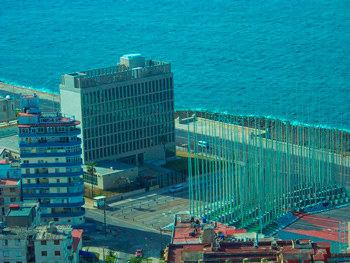Record number of US visas for Cubans
By Wilfredo Cancio Isla (Café Fuerte)

HAVANA TIMES — The United States granted a record 19,500 visas to Cubans for family and professional or business visits during the first half of fiscal 2014 according to State Department data.
According to a report by the United States Interests Section (USINT) in Havana, the number of non-immigrant visas issued was up 27% from the same period of last year. The current US fiscal cycle runs from October 1, 2013.
The Consular Section of USINT also granted – up to March 31 – 11,250 immigrant visas to Cubans as part of bilateral migration agreements established between Havana and Washington in 1994 and 1995.
“With regard to the processing of immigrant visas we are well above the level required to meet the annual figure of 20,000 set by the migration agreements,” a spokesman for the U.S. Interests Section told Diario Las Americas.
More multiple visas
The US consular authorities also revealed that of the visas issued for visits, over 90% included multiple entry into the United States for five years, a category that USINT began granting to Cubans in August 2013.
Most non-immigrant visas are for family visits (B2), but a significant portion (identified as B1) are intended for business or professional reasons such as art exhibitions, academic and cultural conferences and events .
The numbers of visas in both categories in 2014 shows an unprecedented rise for Cuban citizens in the last decade, with more than 30,750 visas granted at the end of the fiscal first half. During the 2013 fiscal year, the U.S. Interests Section issued 32,254 visitor visas and 24,727 immigrant visas.
The granting of US visas to Cuban-Americans has gradually been relaxed by the administration of Barack Obama. Starting in 2009, Washington has provided more than 133,000 visitor visas and says it has strictly complied with the issuing of at least 20,000 immigrant visas per year in compliance with the agreements with Cuba.
Immigration Reform
At the same time, applications by Cubans to travel to the United States have soared since January 2013, after the government of Raul Castro enacted immigration reforms eliminating exit permits to nationals.
“As the United States and Cuba loosen up the normal flow of people, it is only natural for a continuous bridge of visitors and immigrants to be established,” said Juan Antonio Blanco, international relations expert and professor at Miami Dade College.
White believes that the policy of the Obama administration has been successful in “not losing time” in normalizing relations with the Cuban government while increasingly focusing on rapprochement with the Cuban population.
“Actually, there has been an improvement in relations with the Cuban people, but not with the Cuban government,” said the academic. “This policy of differentiated rapprochement has been applied very clearly by this administration.”
A migratory illusion
As far as analyst Sergio Comas is concerned, normalization of migratory relations is still “an illusion.”
“You have to ask yourself why when Cuba did away with the exit permit and the United States has opened the floodgates for more legal immigrants and visitors of all kinds, people still keep leaving in rafts or crossing the border into the US from Mexico,” said Comas.
The new Cuban immigration regulations allow travelers to stay up to 24 months abroad without losing their rights as citizens, leaving the option open to Cuban visitors to the United States to use the Cuban Adjustment Act to obtain legal residence before returning to the island.
Comas believes the precarious economic situation on the island is forcing many Cubans to emigrate in search of money to support their families or to invest in private business initiatives.
“Being able to get a multiple visa and being able to come and go to visit family or as an artist are very enticing,” he said.
NON-IMMIGRANT VISAS FOR VISITING FAMILY, ACADEMIC AND CULTURAL EXCHANGES AND BUSINESS TRAVEL (2004-2014)
2004 – 10.508
2005 – 11.632
2006 – 7.330
2007 – 10.614
2008 – 11.060
2009 ¬ 17.690
2010 ¬ 20.768
2011 – 16.654
2012 – 15.983
2013 – 32.254
2014 – 19.500 (October 2013 – March 2014)
Source: United States Interests Section (USINT)






Having a hard time processing that one, dude? Why would 32,000 Cubans want to leave Castro’s wonderful socialist paradise last year? And you were possibly under the misconception it was the US Blockade that kept Cubans imprisoned on their heroic island?
WTF
I hope the knuckleheads who parrot the Castro propaganda about brutal and inhumane war are able to read this post. Between the increase in remittances to Cuba and this increase in visa approvals, where is the war? Maintaining the embargo and squeezing the Castros capacity to repress the Cuban people should be applauded by anybody who claims to love democracy and freedom. This post highlights the difference between ‘anti-Castro’ and ‘anti-Cuban’. More visas give Cubans the opportunity to escape Castros’ tyranny without putting dollars directly into the Castro treasury.